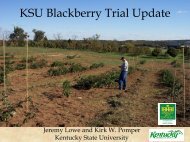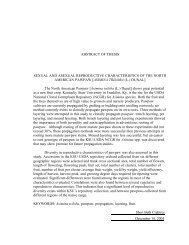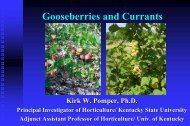Kentucky State University Pawpaw Grafting Update
Kentucky State University Pawpaw Update
Kentucky State University Pawpaw Update
- No tags were found...
You also want an ePaper? Increase the reach of your titles
YUMPU automatically turns print PDFs into web optimized ePapers that Google loves.
<strong>Kentucky</strong> <strong>State</strong> <strong>University</strong><br />
<strong>Pawpaw</strong> <strong>Grafting</strong> <strong>Update</strong><br />
Sheri Crabtree and Dr. Kirk Pomper<br />
KSU Land Grant Program
• <strong>Pawpaw</strong> has great<br />
potential as a new<br />
alternative fruit crop for<br />
limited resource<br />
farmers<br />
• <strong>Pawpaw</strong> cultivars are<br />
generally propagated<br />
by chip-budding the<br />
desired variety onto a<br />
seedling rootstock
• Leaving 6-86<br />
8 leaves on the rootstock seedling when<br />
chip-budding pawpaw may increase bud take and<br />
scion growth<br />
• The remaining rootstock leaves will provide energy<br />
for the developing scion bud, until the bud has<br />
initiated leaves and is able to photosynthesize and<br />
support its own growth<br />
• After approximately 6 weeks, the rootstock’s<br />
leaves would be pruned away, leaving the new<br />
scion shoot
• The objective of this study was to determine<br />
if leaving 6-86<br />
8 leaves on pawpaw seedling<br />
rootstocks for 6 weeks will enhance scion<br />
bud break and growth<br />
• The experiment consisted of:<br />
• 2 pawpaw scions (Sunflower and Susquehanna)<br />
• 2 seedling rootstocks (Sunflower and K8-2)<br />
• 2 leaf treatments (removing all leaves at time of<br />
grafting vs leaving 6-86<br />
8 leaves on the grafted tree)
• Dormant budwood was grafted onto actively<br />
growing 1 year old seedlings in the greenhouse in<br />
June 2006<br />
• Data was collected weekly on scion budbreak<br />
and leaf number<br />
• Rootstock shoots were removed after 6 weeks
• Scion cultivar did not affect chip bud take<br />
or scion leaf number<br />
• Chip buds on K8-2 2 rootstock had a<br />
higher percentage take than those<br />
budded onto Sunflower rootstock. There<br />
was not a significant difference in scion<br />
leaf number between rootstocks
• Chip-budded pawpaws with leaves remaining<br />
on the rootstock seedling had a higher<br />
percentage bud take than chip-budded<br />
pawpaws on which the rootstock’s s leaves had<br />
been removed when budded<br />
• Budded pawpaw trees which had the<br />
rootstock’s s leaves removed when grafted had<br />
more scion leaves than trees on which<br />
rootstock leaves were retained for 6 weeks<br />
after grafting
Conclusions<br />
• While rootstock leaf retention was beneficial for<br />
graft union development, the resulting scions<br />
actually had fewer leaves.<br />
• <strong>Pawpaw</strong> chip-bud emergence improves by<br />
leaving 6-86<br />
8 leaves on the rootstock to support<br />
the scion budbreak and growth.<br />
• These leaves should be removed after 6 weeks<br />
to encourage scion growth.
Take-home message<br />
• When chip-budding pawpaw, leave 6-86<br />
leaves on the rootstock shoot to support<br />
scion growth<br />
• Remove these leaves 6 weeks after<br />
scion bud emerges to improve scion<br />
growth
Questions?<br />
• Sheri Crabtree (502) 597-6375<br />
sheri.crabtree@kysu.edu<br />
• Dr. Kirk Pomper: (502) 597-5942<br />
5942<br />
kirk.pomper@kysu.edu<br />
• <strong>Pawpaw</strong> Information Website:<br />
www.pawpaw.kysu.edu








